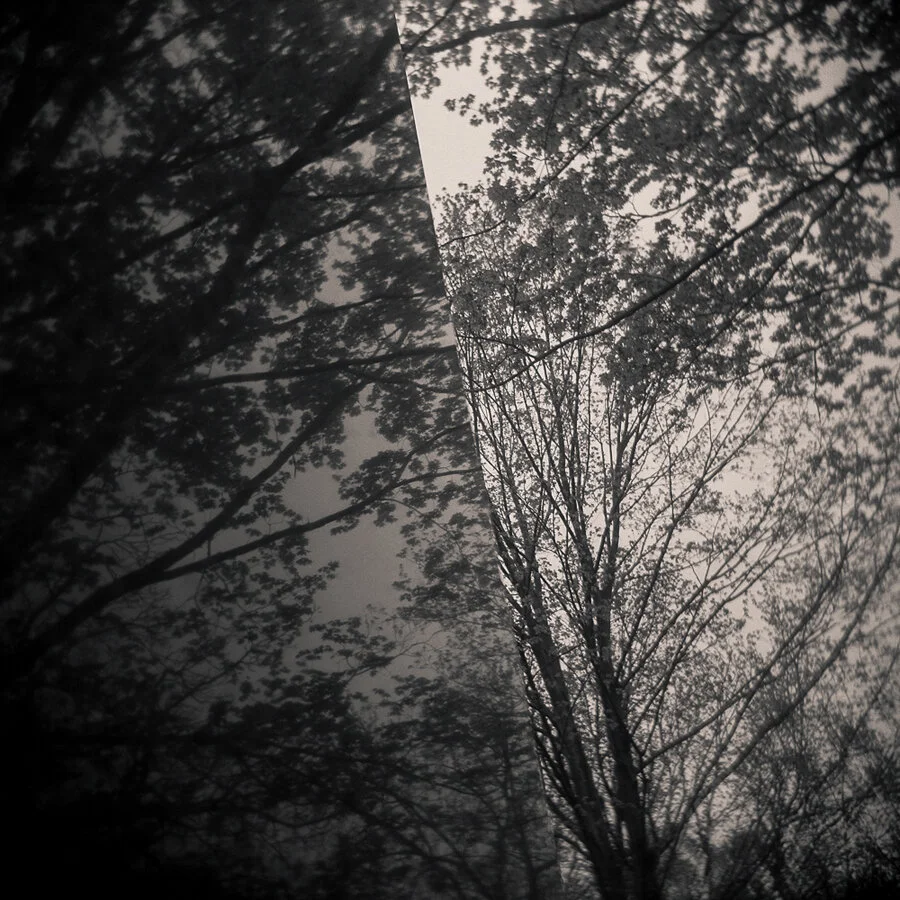Bill Franson
In the right hands, everyday objects and ordinary spaces develop a personality of their own. Questions about their meaning or significance seep into our consciousness. Ubiquity is excellent subject matter, and Bill Franson has a knack for capturing it in a way that seizes and holds our attention. A white dress, a discarded toy, birds shooting across the sky—each are propelled from the commonplace to the extraordinary.
There are twelve images presented at Aspect Initiative this month, representing four of Franson’s series: (de)vice, Mason Dixon, Iron Things, and The Structure of Everyday Life. Each series varies in subject, with an approach by the artist that requires the use of different cameras, but they are united in their attention to how our notions of public and private coalesce. Whether we are looking at ideology along the Mason-Dixon Line, personal familial objects, or gazing at someone whose device makes them oblivious to all around them—how do we view boundaries? Franson’s use of the word “structure” in one of his series is apt, and he notes that the works are, “unified by an overarching preoccupation with the various boundaries that separate.” The awareness of borders, both physical and metaphorical, permeates these works.
- Jessica Roscio, Curator Danforth Museum, Initiative contributor
The first image I made as a young photographer that resonated for me was of a face on a torn poster staring out from a gritty, grafittied train station wall. Most of the text was torn off except the letter “G” and the phrase “is here”. That image replicated an uncanny sense of presence, on a wall that suggested a whole other world behind it.
Statement
The first image I made as a young photographer that resonated for me was of a face on a torn poster staring out from a gritty, grafittied train station wall. Most of the text was torn off except the letter “G” and the phrase “is here”. That image replicated an uncanny sense of presence, on a wall that suggested a whole other world behind it. Since then I recognize I’m working through variations on the theme of presence/absence, here/there, connection/disconnection, and knowable/unknowable, responding with various film formats that fit the way I want to explore the question posed. For instance, “The Structure of Everyday Life” is a Holga based project with images that mimic the way we often live our lives: focused on the things directly before us, but becoming more indistinct toward the outer edges of what could be considered the bigger picture. The plastic lens on a Holga offers an obscure “now I see through a glass darkly” quality. A second project, “Iron Things”, came to mind while reading Mary Oliver’s book length poem The Leaf and the Cloud. In the poem Mary speaks of the iron things, those matters that weighed her parents down, are not ones she is willing to carry herself. This project is a contemplative one, questioning and examining trifling objects I saved from my parents house which seem to contain rich memories, but memories not my own. Because of the projects meditative nature I’m working with a large format camera, which forces me to slow down, the large negative articulating so much detail yet, in true photographic fashion, unable to answer the larger questions posed.
“Mason-Dixon” is a project exploring various layers of an original American boundary. The original pre-revolutionary purpose of the Mason Dixon Line was to settle a boundary dispute between two colonial families over property granted them by the King of England. It is more famous for its separation of states for and against emancipation during the Civil War. At the same time I am looking at the region along the Mason Dixon line with contemporary eyes, considering the immediate ideological issues that separate us as an American people. For this project I am using medium format equipment for its portability and resolution.
Finally, “(de)vice” explores our current preoccupation with our phones. The sight of individuals listening to, talking into, or staring at their devices, closed off from those around them is disquieting, and all too common. Because of our contemporary confusion over what is public and what is private I am brushing up against a prevalent attitude that candid photography is somehow invasive, and inappropriate. This is a street project, requiring a quick intuitive response, and is shot with a 35mm rangefinder.
These four bodies of work are distinct in nominal subject matter and technical approach, yet unified by an overarching preoccupation with the various boundaries that separate.
-Bill Franson
Bill Franson
Bio
Bill Franson was born and raised on Boston’s North Shore. His mother was a regional professional watercolor artist and his father an aerospace engineer. Looking back on his upbringing and influences, making art with a camera seems an obvious destination.
He studied photography at the Art Institute of Boston with a concentration in documentary photography and graduated with a BA (philosophy major, art minor) from Calvin College. He worked commercially for twenty years, first as a staff photographer, then freelance, but always with a gnawing desire to create work that was more personal, and permanent.
Bill is a professor of photography at the New England School of Photography in Boston and at Gordon College in Wenham Massachusetts. His images are exhibited nationally. In 2015, 2011, and 2003 his photographs were included in the highly selective New England Photography Biennial at the Danforth Museum of Art in Framingham, Ma. Bill is represented by Rafius-Fane Gallery in Boston and his work is held in numerous private and institutional collections.
Visit Bill













